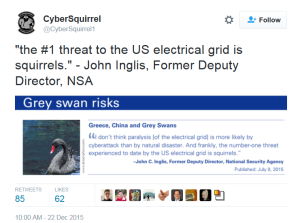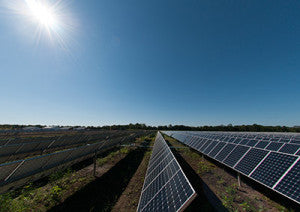Over the last year, experts and journalists have been sounding the call: The U.S. power grid is not secure.
The U.S. military’s Defense Advanced Research Projects Agency announced in December a $77 million effort to improve utilities’ cyber security. A book released in October by
respected journalist Ted Koppel suggested a worst-case scenario for a cyber attack on the power grid could leave tens of millions of people without power for weeks or more, causing mass chaos.
USA Today ran a series about the frequency and possible results of power grid attacks.
So, why aren’t people paying more attention?

Maybe because squirrels have caused more damage to the power grid than hackers,
according to the former deputy director of the National Security Agency, John Inglis.
He has a point. The small animal world is in a war with the power grid, according to the humorous Twitter account
CyberSquirrel. In January alone, more than 45,000 people in 14 states and two countries lost power because of animals, CyberSquirrel reported. Of course, the January 24 blizzard that clobbered the east coast caused power outages for
more than 250,000 people. Maybe the small animal war is just a police action.
Whether it’s caused by squirrels, snow, or hackers, a sudden power loss can be devastating to communications and computing. Having a power source can make a huge difference.
[caption id="attachment_20030" align="alignright" width="300"]

Solar panels contribute to 5.5% of Princeton's microgrid power - photo via Princeton University[/caption]
Princeton University’s microgrid is a great example of this. The university has an on-campus power network, called a microgrid, that gets power from a nearby generator and solar panel field. Normally, the university is connected to the surrounding power grid and both takes from and supplies power to that grid. However, during Hurricane Sandy, after power went down to the rest of the area, Princeton’s microgrid was able to disconnect from the main grid and power the campus. For a day and a half, until the town got power back, emergency workers were able to use the university to recharge phones and equipment. The university also set up a hospitality area where local residents could warm up, recharge electronic devices and use wireless Internet service.
“For a day and a half, we had to generate everything the campus needed,” said Ted Borer, Princeton's energy plant manager,
in a Princeton news story. “Now, we can run the campus as an electric island in times of crisis.”
Here are some ways to turn your home into an electric island, from
Ready.gov, the
American Red Cross, and the
U.S. Department of Energy.
- Have a fully stocked emergency kit including food and water, a flashlight, batteries, cash in small bills and first aid supplies.
- Keep your cell phone and other battery-powered devices charged and have an alternative charging method, like a generator. If you have an electric garage door opener, know how to release it manually.
- Keep your car’s gas tank full. You can run a vehicle for power, but not in an enclosed space, unless you like carbon monoxide poisoning.
- If you use a power-dependent or battery-operated medical device, tell your local utility so it can prioritize your home. Have a backup plan.
- Replace out where to buy dry ice. Fifty pounds will keep a fully stocked fridge cold for two days. Without it, an unopened fridge will keep food cold for only about four hours. A half-full, unopened freezer will keep food cold for about 24 hours. Food in a packed, unopened freezer will stay cold for twice that long.
And watch out for squirrels. Behind those bushy tails and beady eyes, they’ve got to be hiding something.

 Maybe because squirrels have caused more damage to the power grid than hackers, according to the former deputy director of the National Security Agency, John Inglis.
He has a point. The small animal world is in a war with the power grid, according to the humorous Twitter account CyberSquirrel. In January alone, more than 45,000 people in 14 states and two countries lost power because of animals, CyberSquirrel reported. Of course, the January 24 blizzard that clobbered the east coast caused power outages for more than 250,000 people. Maybe the small animal war is just a police action.
Whether it’s caused by squirrels, snow, or hackers, a sudden power loss can be devastating to communications and computing. Having a power source can make a huge difference.
[caption id="attachment_20030" align="alignright" width="300"]
Maybe because squirrels have caused more damage to the power grid than hackers, according to the former deputy director of the National Security Agency, John Inglis.
He has a point. The small animal world is in a war with the power grid, according to the humorous Twitter account CyberSquirrel. In January alone, more than 45,000 people in 14 states and two countries lost power because of animals, CyberSquirrel reported. Of course, the January 24 blizzard that clobbered the east coast caused power outages for more than 250,000 people. Maybe the small animal war is just a police action.
Whether it’s caused by squirrels, snow, or hackers, a sudden power loss can be devastating to communications and computing. Having a power source can make a huge difference.
[caption id="attachment_20030" align="alignright" width="300"] Solar panels contribute to 5.5% of Princeton's microgrid power - photo via Princeton University[/caption]
Princeton University’s microgrid is a great example of this. The university has an on-campus power network, called a microgrid, that gets power from a nearby generator and solar panel field. Normally, the university is connected to the surrounding power grid and both takes from and supplies power to that grid. However, during Hurricane Sandy, after power went down to the rest of the area, Princeton’s microgrid was able to disconnect from the main grid and power the campus. For a day and a half, until the town got power back, emergency workers were able to use the university to recharge phones and equipment. The university also set up a hospitality area where local residents could warm up, recharge electronic devices and use wireless Internet service.
“For a day and a half, we had to generate everything the campus needed,” said Ted Borer, Princeton's energy plant manager, in a Princeton news story. “Now, we can run the campus as an electric island in times of crisis.”
Here are some ways to turn your home into an electric island, from Ready.gov, the American Red Cross, and the U.S. Department of Energy.
Solar panels contribute to 5.5% of Princeton's microgrid power - photo via Princeton University[/caption]
Princeton University’s microgrid is a great example of this. The university has an on-campus power network, called a microgrid, that gets power from a nearby generator and solar panel field. Normally, the university is connected to the surrounding power grid and both takes from and supplies power to that grid. However, during Hurricane Sandy, after power went down to the rest of the area, Princeton’s microgrid was able to disconnect from the main grid and power the campus. For a day and a half, until the town got power back, emergency workers were able to use the university to recharge phones and equipment. The university also set up a hospitality area where local residents could warm up, recharge electronic devices and use wireless Internet service.
“For a day and a half, we had to generate everything the campus needed,” said Ted Borer, Princeton's energy plant manager, in a Princeton news story. “Now, we can run the campus as an electric island in times of crisis.”
Here are some ways to turn your home into an electric island, from Ready.gov, the American Red Cross, and the U.S. Department of Energy.

